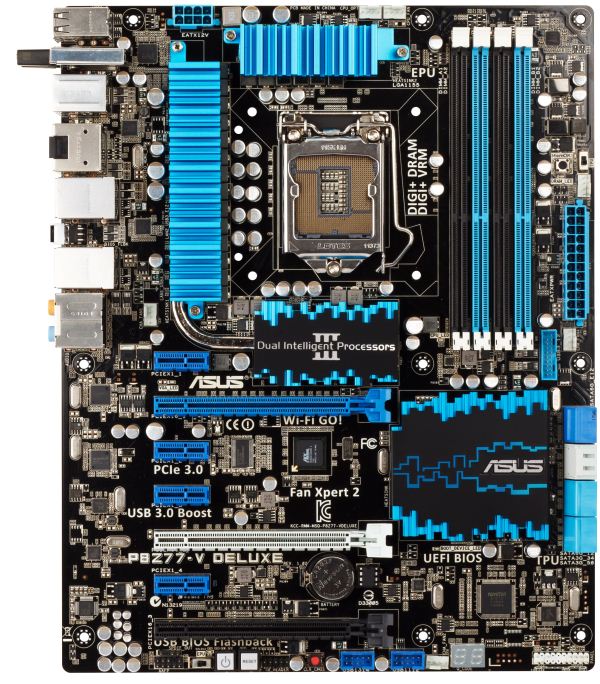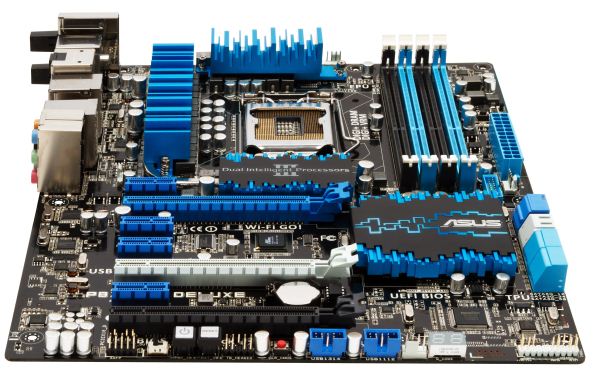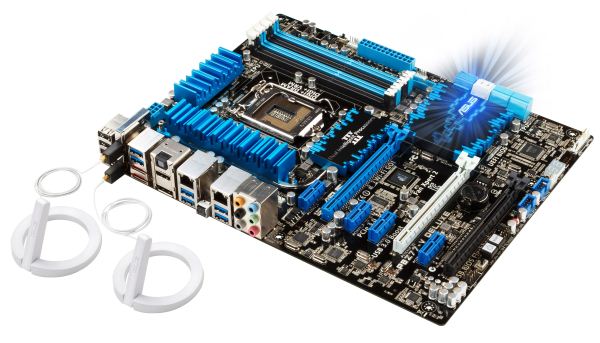Intel Z77 Panther Point Chipset and Motherboard Preview – ASRock, ASUS, Gigabyte, MSI, ECS and Biostar
by Ian Cutress on April 8, 2012 12:00 AM EST- Posted in
- Motherboards
- Intel
- Biostar
- MSI
- Gigabyte
- ASRock
- Asus
- Ivy Bridge
- ECS
- Z77
ASUS P8Z77-V Deluxe—Visual Inspection
In the next notch up in the channel board segregation, ASUS sell the Deluxe. This will be the first ASUS Deluxe board we have reviewed at AnandTech since the Llano mini-ITX F1A75-I Deluxe last year. In comparison to the P8Z77-V Pro, the Deluxe features several upgrades in terms of functionality and comfort.
The first to note is the increased power delivery to the CPU—this time in the form of a 16 + 4 phase power delivery. As a result, the VRM heatsinks to the left of the CPU are directly connected via a heatpipe to another heatsink below the socket. Also on board are the ‘enthusiast’ power/reset buttons and two-digit debug that we did not see on the Pro, and the use of dual NICs on the I/O, in the form of an Intel 82579V and a Realtek 8111F.
Due to the positioning off the heatsinks on the Deluxe compared to the Pro, the socket area seems a bit smaller (for example, the left hand heatsink is moved further in towards the socket), meaning that big air coolers may have a tougher time if they do not fit into Intel’s socket specification. Around the socket itself, we still have access to five fan headers—two 4-pin on the top of the board, one 4-pin to the bottom left of the main VRM heatsink, and one 4-pin either side of the 24-pin ATX power connector. A sixth fan header on board is found at the bottom next to the two-digit debug output.
Above the main power connector on the right hand side are the MemOK button and the TPU switch (for a fast automatic overclock). Below it is a USB 3.0 header, and a set of eight SATA ports. Similar to the ASUS Pro, we have four SATA 3 Gbps from the PCH, two SATA 6 Gbps also from the PCH, and two SATA 3 Gbps from a different controller—the Marvell 9128. This allows RAID 0/1 on these two SATA 6 Gbps ports.
The south side of the board still contains front panel headers and USB 2.0 ports, but also comes with the aforementioned power/reset buttons and two-digit debug display. We also find a ClearCMOS button on board, useful for overclockers. There is also a header labelled 'TB_Header', which should mean Thunderbolt, but there is no mention of it in the specifications. I will have to check up on this.
Update: The TB_Header is actually for a new Thunderbolt add-in card that ASUS will be selling. This is aimed to go into the x4 slot and provide Thunderbolt connectivity. MSRP will be around the $30-$40 mark so I am told.
In terms of the PCIe, we have a little bit of confusion. While in the middle between the PCIe is a PLX chip, it is not the PLX PXE 8747 chip that increases PCIe lane count. The one on the Deluxe is just to provide extra data transfer access for the various controllers on the motherboard. This means that the third full length PCIe in black is like other boards in that this is a PCIe 2.0 x4, non-GPU port. So from the top, we have a PCIe x1, x16 (x8 in Multi-GPU), x1, x1, x8, x1, x4. As a result, there is no PCIe to PCI bridge chip on this high-end model for PCI slots.
For the back panel, ASUS have done a juggling act deciding what to include. On the far left is a set of four USB 2.0 ports (black), a mini-PCIe WiFi + Bluetooth module, two USB 3.0 (blue), two eSATA, optical SPDIF output, HDMI output, DisplayPort, dual gigabit Ethernet, another four USB 3.0 ports (blue), a BIOS flashback button, and audio outputs. So in the name of a double NIC and 10 total USB ports on the back panel, we have lost D-Sub, DVI, IEEE1394 and a ClearCMOS button.
Board Features
| ASUS P8Z77-V Deluxe | |
| Size | ATX |
| CPU Interface | LGA-1155 |
| Chipset | Intel Z77 |
| Power Delivery | 16 + 4 |
| Memory Slots |
Four DDR3 DIMM slots supporting up to 32 GB Up to Dual Channel |
| Video Outputs | DisplayPort, HDMI |
| Onboard LAN |
Intel 82579V Realtek 8111F |
| Onboard Audio | Realtek ALC898 |
| Expansion Slots |
2 x PCIe x16 Gen3 (x16, x8/8) 1 x PCIe x16 Gen2 (x4) 4 x PCIe x1 Gen2 |
| Onboard SATA/RAID |
2 x SATA 6 Gbps (PCH), Support for RAID 0, 1, 5, 10 2 x SATA 6 Gbps (Marvell PCIe 9128), RAID 0, 1 4 x SATA 3 Gbps (PCH), Support for RAID 0, 1, 5, 10 2 x eSATA 6 Gbps (ASMedia) |
| USB |
Four USB 3.0 at rear (2 PCH, 2 ASMedia) Two USB 3.0 headers on board (PCH, ASMedia) Eight USB 2.0 (4 back panel, 4 on board) |
| Onboard |
4 x SATA 6 Gbps 4 x SATA 3 Gbps 1 x USB 3.0 Headers 2 x USB 2.0 Headers 6 x Fan Headers 1 x SPDIF Header 1 x Front Panel Audio Header 1 x TB Header MemOK! Button TPU/EPU Switches USB Flashback Button Power/Reset Buttons |
| Power Connectors |
1 x 24-pin ATX connector 1 x 8-pin 12V connector |
| Fan Headers |
1 x CPU Fan Header (4-pin) 4 x CHA Fan Headers 1 x OPT Fan Header |
| IO Panel |
2 x eSATA 6 Gbps 1 x DisplayPort 1 x HDMI 1.4a 2 x Gigabit Ethernet 6 x USB 3.0 4 x USB 2.0 1 x Optical SPDIF Audio Outputs Bluetooth V4.0 Wifi USB Flashback |
| Warranty Period | 3 Years |
| Product Page | Link |
Obviously one of the main selling points of the board is the onboard WiFi and Intel NIC (alongside a Realtek NIC).














145 Comments
View All Comments
mechjman - Monday, April 9, 2012 - link
I don't remember seeing PCIe 3.0 support straight from P6x series chipsets.http://www.intel.com/content/www/us/en/chipsets/ma...
If this is regarding in use with a PLX chip, it might be good to state so.
extide - Tuesday, April 10, 2012 - link
It's actually when the boards DONT use a plx chip, or if the use 3.0 capable ones. It's only the boards that use 2.0 chips that are limited to 2.0GameLifter - Tuesday, April 10, 2012 - link
I am very curious to see how this technology will affect the overall performance of the RAM. If it works well, I may have to get the P8Z77-V Pro.jbuiltman - Tuesday, April 10, 2012 - link
I am leaving my AMD FX-60, 3 GB DDR, Asus 939 Delux, Win XP, Raptor 150 HDD for IVY Bridge pasures!!!I am all for ASUS 16+4 power, multi usb 2.0 and 3.0 on the back panel. I also like the multiple 4 pin fan plug ins, mem ok, LED problem indicator, switches, 4 SATA 6GB connectors and heat pipes connecting the alunimum fins.
What i want to see is 16x/16x not 8x/8x on dual video card on a Z77 board. ASUS, don't skimp for a measly $30! I hate cheap companies and don't make me think you are just being cheap!!!
jbuiltman - Tuesday, April 10, 2012 - link
Hey all you MoBo companies. Don't get cheap with the Z77 boards and not include 16x/16x on the pci-e 3.0!!!! Come on, add what you need to and pass the $30 on to me!!!!ratbert1 - Wednesday, April 11, 2012 - link
"ASUS as a direct standard are now placing Intel NICs on all their channel motherboards. This is a result of a significant number of their user base requesting them over the Realtek solutions."Um... ASUS P8Z77-V LX has Realtek!
and...ASUS P8H77-M PRO has Realtek!
There are more.
ratbert1 - Wednesday, April 11, 2012 - link
I meant P8Z77-M PRO, but the H77 has it as well.lbeyak - Sunday, April 15, 2012 - link
I would love a detailed review of the Gigabyte G1.Sniper 3 Z77 board when it becomes available.Keep up the good work!
csrikant - Sunday, April 22, 2012 - link
Dual E5-2690So far best i have got burn a lot $$$ to get this right
my last build was with I7 990x got itchy in oct 2011 with some minor issue decided to change my PC got my i7 2700K did not meet my expectation
built i7 3960x still failed many of my requirements regret my pc change from 990x
Finally with all my pain and wasting$$ got my new build that so far perform better than my 990X build
My advice do not get carried away by fancy new i7 release they are just little benefit for P4 just wasting time I was shocked that they released P4 with 1155 socket it was having same performace as 2700K not much change in fact it was cheaper too.
Am not expert an average system builder but my advice from bottom of my heart is just go for E5 build if you are really looking for performace and some benefits you may spend some extra $$ on MB ,CPU,Casing etc it is worth in long run works out cheper than any fancy High end gaming rig water cooling etc all just shit tech advice. Never get ferrari performance form mod toyota.
mudy - Monday, April 23, 2012 - link
With the third pcie lane on the z77 boards I have come across almost all manufacturers saying "1xPCI Express 2.0 x16 (x4 Mode) & only available if a Gen 3 CPU are used". Does this mean that the lane is pcie 2.0 at x16 but works at pcie 3.0 x4 mode, if an IVB processor is connected, and other two pcie 3.0 lane is populated giving x8/x4x4 speed with pcie 3.0 compliant cards?? Also what will happen if I put Pcie 2.0 GPUs in the first two pcie 3.0 x16 slots and a pcie 2.0 compliant raid card (rr2720SGL) in the third pcie lane? Will it give me an effective pcie 2.0 bandwidth of x16/x8/x8 or not?? Damn these are so confusing!! I wish anandtech would do an extensive review on just the pcie lanes covering all sorts of scenario and I think NOW would be the best time to this as the transition from pcie 2.0 to pcie 3.0 will happen slowly (maybe years) so majority end-user will still be keeping their pcie 2.0 compliant devices!!Thanks